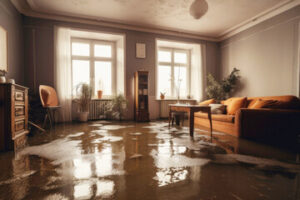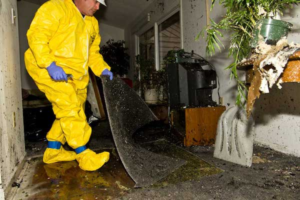Disaster cleanup is the process of repairing and restoring areas devastated by natural or man-made catastrophes. It involves several stages and multiple professionals. Reach out to All Pro Services for expert assistance.

Individuals, communities, and NGOs also play an important role in disaster response. This article explores five different aspects of disaster cleanup responsibility.
Debris removal is an important aspect of disaster cleanup, especially after a major natural event. It helps clear the way for emergency responders and others to safely travel through the affected area. It also helps prevent environmental damage by reducing the amount of waste that is deposited in the area.
In addition, debris removal helps minimize the potential for additional damage to structures. It also allows for the safe re-entry of residents into their homes once it is safe to do so.
The types of debris that need to be removed during a disaster depend on the type of event that caused the problem. Hurricanes, for example, can generate enormous quantities of debris. Other examples of debris are sandbags, appliances, construction and demolition (C&D) materials, vegetation, household waste, and a host of other categories of items.
Some of this material can be recycled, while other debris needs to be disposed of in a specific manner. For this reason, it’s crucial to have an established process for handling debris following a disaster. This process should be reviewed and updated as necessary, in order to keep pace with current requirements.
Local governments are typically responsible for debris removal efforts, but they may need to rely on the assistance of volunteer and nonprofit organizations to supplement their own resources. These entities can provide workers and equipment, as well as help with other aspects of the recovery effort. These partnerships can be beneficial for a number of reasons, including the fact that they can help cut costs and increase efficiency during disaster recovery efforts.
While it is not a requirement for volunteers and nonprofits to participate in disaster recovery efforts, they can be an invaluable asset during this time of need. Their help can reduce the burden on local governments, which is essential for speeding up the recovery process.
In the aftermath of a natural disaster, it is important to follow local government guidance regarding debris removal. It is essential to wear personal protective equipment, such as a hard hat, N95 mask, goggles, gloves and sturdy shoes. Additionally, it is crucial to identify and stay away from unstable structures as these pose a safety hazard.
Structural Repairs
Structural repairs are a key part of disaster restoration that return buildings and infrastructure to their pre-disaster condition. This includes repairing roofs, walls, electrical systems, plumbing, roads, bridges, and more. Engineers and construction professionals work to ensure that these repairs meet or exceed safety standards and building codes to prevent future disasters.
After the initial debris removal and securing the property is complete, professionals assess the damage to create a comprehensive restoration plan. This step involves documenting all affected areas and identifying any hazards that may require special attention. It also determines the time and resources needed to restore each area.
Once the assessment is completed, restoration services begin to repair the damage and restore the property to its pre-disaster condition. This will involve restoring everything from drywall and insulation to electrical systems and plumbing. Licensed electricians will restore wiring and outlets while plumbers will handle pipe fittings, water lines, and more. Additionally, the restoration process will include specialized tasks like deodorization and mold remediation.
This process is often difficult because many items have been rendered unusable by water damage, fire, or other disasters. However, it is important to make these repairs as quickly as possible to avoid further structural damage and health risks.
During this stage, technicians will use high-sensitivity moisture meters to guide specialized drying and dehumidification equipment that removes moisture from structures like wooden rafters and concrete walls. They will then replace and repair drywall, clean surfaces, and disinfect and sanitize rooms. They will also check for underlying problems, such as foundational cracking or undermining that could lead to further damage in the future.
As the restoration process continues, salvageable items will be cleaned and restored. This can include deep cleaning and sanitizing for furniture, freezers, computers, precious documents, and other items. If any items are deemed beyond repair, they will be removed and replaced with new items. Additionally, air sanitization and filtration systems will be installed to ensure that the space is safe for reoccupancy.
Cleaning and Sanitizing
Disaster cleanup is a crucial step in the recovery process following natural or man-made disasters. It involves the removal of debris, repair of damaged structures, and cleaning and sanitizing the affected area. It also involves making sure that the site is safe for rebuilding and re-occupancy. Disaster cleanup is a complex task and requires the cooperation of many different government agencies and organizations. These include the Federal Emergency Management Agency, the Department of Homeland Security, and the Environmental Protection Agency.
The first step in disaster cleanup is assessing the damage. This includes determining whether there are any dangerous chemicals, pathogens, or walking hazards and evaluating the condition of buildings. It is also important to document the damage in case insurance claims are needed. This will help ensure that residents and business owners receive the proper compensation for their losses.
Once the assessment is complete, the cleanup and sanitizing can begin. This may involve removing and disposing of contaminated materials, washing and disinfecting surfaces, and sanitizing drinking water. It is also important to monitor and contain mold growth, which can be a significant problem after flooding or fires.
During this stage, it is important to remember that safety should be the top priority. There are many dangers associated with disaster cleanup, including dirty water, live wires, and shaky structures. It is also important to wear personal protective equipment and follow all environmental regulations.
While local, state, and federal governments play a major role in disaster cleanup, individuals and communities are responsible for the initial response. This includes ensuring their own safety, assisting those in need, and volunteering to help with cleanup efforts. It is also important to stay healthy and eat well during this time.
It is a good idea to hire professional disaster cleanup services for the most effective results. They have the necessary experience and equipment to handle a wide variety of cleanup situations. A reputable service will also follow all environmental regulations, use advanced equipment, and be licensed and insured. These factors will help ensure that the cleanup is done safely and quickly.
Restoration
Once the immediate threat from a natural disaster has passed, it’s time to begin the cleanup process. Disaster restoration is a multifaceted endeavor that involves assessing the damage, prioritizing tasks, and hiring professional services for specialized help when necessary. Local and state governments also play a significant role in disaster cleanup by providing assistance and coordinating recovery efforts.
The first priority during disaster cleanup is to restore vital utilities such as electricity, water, and gas. This involves repairing and restoring power lines and substations, and testing the water and gas to ensure they are safe for use. Additionally, it’s important to clean and sanitize the area after a disaster, which can involve removing debris, disinfecting surfaces, and removing any contaminated materials.
Fires are one of the most devastating disasters that can affect a home or business. They can cause structural and cosmetic damage, leaving behind soot, smoke, and other toxins that can stain walls, ceilings, and furniture. Professional disaster cleanup crews will work to remove these toxins and salvage as much of your property as possible.
Thunder and lightning can also leave a considerable amount of damage, including stone, concrete, plaster, brick, and wood damage, as well as cracked window glass and damaged contents. Disaster cleanup companies can safely and quickly remove these damages, making your property like it was before the disaster.
Individuals and communities also play a major role in disaster cleanup by assisting with response efforts, volunteering to assist with the cleanup effort, and taking precautions to reduce the risk of future disasters. These precautions can include investing in disaster-resistant infrastructure, implementing disaster prevention measures, and educating the community about disaster preparedness.
If you’re in need of disaster cleanup, it’s important to choose a company that offers a full range of services. This way, you can have all your needs addressed in one place. When selecting a company, look for one with good online reviews and plenty of experience. A company that has experience in a variety of disasters will have the skills and expertise to handle any situation.
